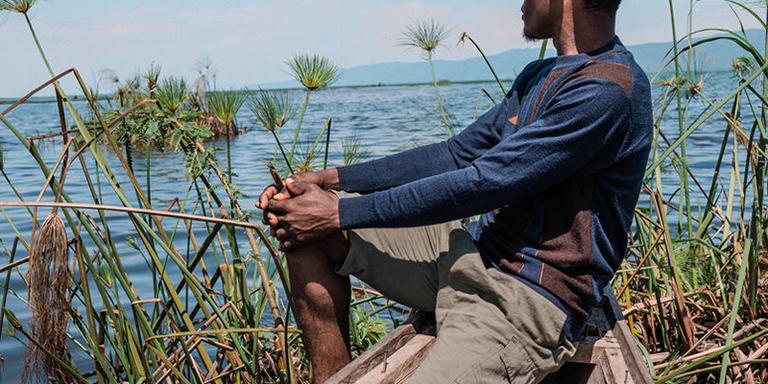
17-year-old Junior*, who spent eight months as a child solider in an armed group in 2018, sits in a canoe nearby his community in Eastern DRC.
17-year-old Junior*, who spent eight months as a child solider in an armed group in 2018, has been provided with professional supervision and psychological support through a local partner of ��ɫ��Ƶin Eastern Democratic Republic of Congo. *Name changed for child’s protection.
Child Soldiers: The Tragic End of Childhood for Boys and Girls in Conflict
There are six UN-verified “grave violations” of children’s rights in conflict. Being recruited and used as a child soldier is one of them.[i]
Save the Children’s Stop the War on Children report, the third in our global series, reveals shocking trends in the threats to innocent children now living and suffering in the world’s war zones:
- 149 million children – double the number of all children in the U.S.[ii] – live in high-intensity conflict zones, areas experiencing thousands of battle-related deaths each year.
- Since 2010, there’s been a 34% rise in the number of children living in conflict-affected areas, plus a staggering 170% rise in the number of reported grave violations committed against children in conflict.
- This includes more child soldiers, as well as those more likely to be killed or maimed, abducted, sexually abused, see their schools or hospitals attacked, or have aid denied to them.
- Children in conflict are more at risk of harm now than at any time in recorded history.
Child soldiers, boys and girls as young as 8 years old, are being recruited and used not only for fighting, but for sexual exploitation and more in conflicts raging across the globe. This isn’t just a grave violation of children’s fundamental human rights – it represents the tragic end of childhood. The world’s children deserve so much better. We must stop the war on children.
��
Learn the facts about child soldiers.
What is the definition of a child soldier?
The official term is “a child associated with an armed force or armed group.” It refers to any boy or girl under age 18 who is recruited or used by an armed force or armed group in any capacity. It does not refer only to a child who is taking a direct part in hostilities.[iii]
How many child soldiers are there?
It’s impossible to know how many child soldiers are associated with armed conflicts around the world. Between 2005 and 2018, a total of 65,081 children are verified to have been recruited and used by armed forces and groups, but actual numbers are likely much higher – as many as hundreds of thousands of children.[iv]
What are child soldiers forced to do?
Child soldiers are boys and girls who are often abducted and used as combatants, forced to act as human shields or conduct executions, deployed as suicide bombers, or used to make or transport explosives. Other roles include working as guards, spies, messengers, porters, cooks or domestic servants.
Many children, more often girls, are subjected to sexual abuse and exploitation, while some are forced into��child marriage��as “brides” for fighters. Girls forcibly married in this way are frequently abandoned, divorced or left widowed, if they’re not killed or maimed themselves.
Why are children recruited and used as child soldiers?
Throughout history, children have been recruited, often by force, and used in military campaigns. Child soldiers may be considered cheaper to recruit and train, more vulnerable to��exploitation and abuse, or strategically useful – such as the girls used for the horrific suicide attacks by Boko Haram in Nigeria.
Armed groups often use gendered recruitment tactics, including a hyper-masculine ideology and imagery that equates power with violence, promises of sexual rewards and “wives” for soldiers.
What happens to former child soldiers?
While every child’s story is different, children formerly associated with armed forces or groups face many immediate and lifelong challenges. Those who survive have most certainly been robbed of their innocence, their childhoods.
These children may suffer from physical, developmental and��mental health conditions. Many have missed out on years of education, severely compromising their futures. And social reintegration might be difficult, as many have lost ties to family and community.
Girls in particular are likely to be stigmatized and even rejected by their community if it’s known that they‘ve been used by an armed force or armed group – and the rejection of their babies and children may be even more severe. Boys returning from conflict also risk rejection by their communities of origin.
For over 100 years,��Save the Children��has been singularly committed to securing children’s rights and serving their needs, giving every child the chance to grow up��healthy,��educated��and��safe.
Thanks to supporters like you, we are��the global leader in child-focused humanitarian response, including protecting child soldiers and other children from the physical and emotional wounds of war, and ensuring their recovery and rehabilitation.
Learn more about our����campaign – and��.
**Sources: Unless otherwise noted, facts and statistics have been sourced from Save the Children’s program and monitoring and evaluation experts, as well as��published reports.
***Photo credit: Lois Leeson / Save the Children.
[i]��.
[ii]��.
[iii]��.
[iv]��.
��
